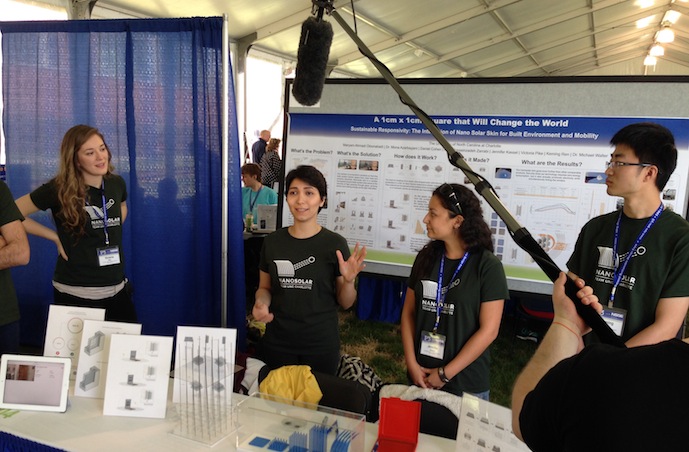A team of six UNC Charlotte students, led by chemistry faculty member Michael Walter and architecture faculty member Mona Azarbayjani, has created a solar-responsive design material that transforms windows into environmentally-responsive surfaces that can simultaneously provide shade and convert sunlight into usable electric energy.
They received honorable mention accolades with their design in the People, Prosperity, and Planet Student Design Competition for Sustainability held by the U.S. Environmental Protection Agency in Alexandria, Virginia, April 10-13.
In the fall of 2014, the UNC Charlotte team received a $15,000 grant to develop a project to address an environmental challenge found in the developed or developing world. They will present their proposal to compete for a P3 Award for grant funding up to $75,000 to further the project design, implement it in the field, and move it to the marketplace. A mixture of undergraduate and graduate students, the UNC Charlotte team includes two students from the Department of Chemistry and one student from the Department of Physics and Optical Science in the College of Liberal Arts & Sciences and three students from the School of Architecture in the College of Arts + Architecture.
With their project design, the unique nature of the material reacts to the intensity of the sunlight striking the window. Excess solar energy is then converted to electricity instead of heating the interior of a building. This material can be incorporated as a very thin layer on a glass surface, which can be used in different parts of the building’s exterior, such as skylights, façades, windows, or curtain walls.
“The purpose of this project is to lower the energy consumption of the building and to have it become more sustainable,” Walter said. “The buildings in the United States are one of the biggest areas where energy is wasted. They contribute so much to the increase in CO2. Think about the energy needed for lighting, heating and cooling.”
 The project could revolutionize the use of glass in homes, buildings, and even automobiles. Here’s how it works: Micro-sized, wire-shaped solar cells are embedded in a thin film of clear, heat responsive plastic material. The film can be put on the surface of an existing window, or between panes when windows are manufactured. The plastic absorbs the heat that the sunlight produces and reacts by expanding, which causes the nearly invisible wires to bend, and in turn causes the window to become tinted. This allows the solar cells to absorb more visible light, increasing the efficiency of the window as a solar panel, which can help feed the building’s energy needs. Once the window cools, the plastic and the wires will return to their original positions
The project could revolutionize the use of glass in homes, buildings, and even automobiles. Here’s how it works: Micro-sized, wire-shaped solar cells are embedded in a thin film of clear, heat responsive plastic material. The film can be put on the surface of an existing window, or between panes when windows are manufactured. The plastic absorbs the heat that the sunlight produces and reacts by expanding, which causes the nearly invisible wires to bend, and in turn causes the window to become tinted. This allows the solar cells to absorb more visible light, increasing the efficiency of the window as a solar panel, which can help feed the building’s energy needs. Once the window cools, the plastic and the wires will return to their original positions
In October, the UNC Charlotte team received a commendation from Governor Pat McCrory. “I would like to congratulate UNC Charlotte on being awarded this grant,” McCrory said. “Innovation and cutting edge projects like these are the best of what North Carolina is about and will undoubtedly impact our environment and future in a positive way.”
In addition to the initial grant from the EPA, the project has been funded by university grants from the Energy Production and Infrastructure Center (EPIC), the Department of Chemistry, and the School of Architecture.
“I feel very lucky to be a part of this effort and in energy research,” said undergraduate physics major Jennifer Kassel, who is part of the Walter Research Group. “Knowing that my time and effort is contributing to the field of sustainability, something I am proud to be a part of, is very fulfilling. I love the projects I get to work on and getting to explain them to anybody who will listen. Also, getting to work with a professor who is very passionate about his work and other students who feel the same makes for a great environment.”
This is not the first time an interdisciplinary team of UNC Charlotte students has conducted research and design in solar energy and sustainability practices for a national competition. Led by Azarbayjani, a group of more than 40 students competed in the 2013 Solar Decathlon, sponsored by the US Department of Energy.
“One of the core objectives of the Solar Decathlon was to turn ideas into research,” Azarbayjani said. “Throughout the competition, we wanted to embrace all aspects of sustainability and the built environment. That’s where the idea of a responsive building envelop was born. This idea then served as a vehicle for our exploration in the P3 competition.”
Since 2004, the P3 Program has provided funding to student teams in all 50 states and Puerto Rico, committing over $10 million to cutting-edge, sustainable projects designed by university students. Nationally the grants were awarded to 42 teams of college and university students this year. Other North Carolina schools receiving the grant include Appalachian State University and North Carolina A&T State University.
Image: Students presenting at competition








